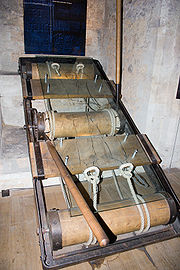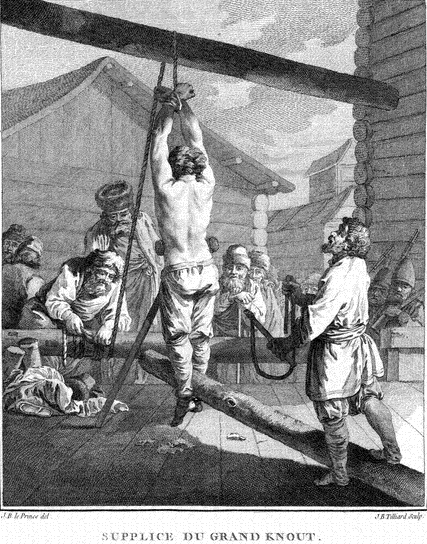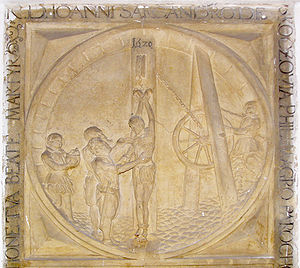
Rack (torture)
Encyclopedia

Torture
Torture is the act of inflicting severe pain as a means of punishment, revenge, forcing information or a confession, or simply as an act of cruelty. Throughout history, torture has often been used as a method of political re-education, interrogation, punishment, and coercion...
device consisting of a rectangular, usually wooden frame, slightly raised from the ground, with a roller at one, or both, ends, having at one end a fixed bar to which the legs were fastened, and at the other a movable bar to which the hands were tied. The victim's ankles are fastened to one roller, and the wrists are chained to the other.
As the interrogation progresses, a handle and ratchet
Ratchet (device)
A ratchet is a device that allows continuous linear or rotary motion in only one direction while preventing motion in the opposite direction. Because most socket wrenches today use ratcheting handles, the term "ratchet" alone is often used to refer to a ratcheting wrench, and the terms "ratchet"...
attached to the top roller are used to very gradually stepwise increase the tension on the chains, inducing excruciating pain. By means of pulleys and levers this roller could be rotated on its own axis, thus straining the ropes until the sufferer's joint
Joint
A joint is the location at which two or more bones make contact. They are constructed to allow movement and provide mechanical support, and are classified structurally and functionally.-Classification:...
s were dislocated and eventually separated. Additionally, if muscle fibers are stretched excessively, they lose their ability to contract, rendering them ineffective.
One gruesome aspect of being stretched too far on the rack is the loud popping noises made by snapping cartilage
Cartilage
Cartilage is a flexible connective tissue found in many areas in the bodies of humans and other animals, including the joints between bones, the rib cage, the ear, the nose, the elbow, the knee, the ankle, the bronchial tubes and the intervertebral discs...
, ligaments, or bones. One powerful method for putting pressure upon prisoners was to force them to watch someone else being subjected to the rack. Confining the prisoner on the rack enabled further tortures to be simultaneously applied, typically including burning the flanks with hot torches or candles or using pincers made with specially roughened grips to tear out the nails of the fingers and toes.
Early use
It was used since antiquityAncient history
Ancient history is the study of the written past from the beginning of recorded human history to the Early Middle Ages. The span of recorded history is roughly 5,000 years, with Cuneiform script, the oldest discovered form of coherent writing, from the protoliterate period around the 30th century BC...
, being used on St. Vincent
Vincent of Saragossa
Saint Vincent of Saragossa, also known as Vincent Martyr, Vincent of Huesca or Vincent the Deacon, is the patron saint of Lisbon. His feast day is 22 January in the Roman Catholic Church and Anglican Communion and 11 November in the Eastern Orthodox Churches...
and mentioned by the Church Fathers Tertullian
Tertullian
Quintus Septimius Florens Tertullianus, anglicised as Tertullian , was a prolific early Christian author from Carthage in the Roman province of Africa. He is the first Christian author to produce an extensive corpus of Latin Christian literature. He also was a notable early Christian apologist and...
(on extraction of confessions from criminals and on persisting Christian 'sacrilegers' against the state religion) and St. Jerome (used on a woman according to his first letter).
Medieval Britain
Its first appearance in England is said to have been due to John Holland, 2nd Duke of ExeterJohn Holland, 2nd Duke of Exeter
John Holland, 2nd Duke of Exeter KG was an English nobleman and military commander during the Hundred Years' War.-Family:...
, the constable of the Tower
Constable of the Tower
The Constable of the Tower is the most senior appointment at the Tower of London. In the middle ages a constable was the person in charge of a castle when the owner - the king or a nobleman - was not in residence...
in 1447, whence it was popularly known as the Duke of Exeter's daughter
Duke of Exeter's daughter
The Duke of Exeter's daughter was a torture rack in the Tower of London. Its presence is said to have been due to John Holland, 2nd Duke of Exeter, the constable of the Tower in 1447, whence it got its name....
.
In 1628 the question of its legality was raised by a proposal in the Privy Council
Privy Council of England
The Privy Council of England, also known as His Majesty's Most Honourable Privy Council, was a body of advisers to the sovereign of the Kingdom of England...
to rack John Felton, the assassin of the Duke of Buckingham
George Villiers, 1st Duke of Buckingham
George Villiers, 1st Duke of Buckingham KG was the favourite, claimed by some to be the lover, of King James I of England. Despite a very patchy political and military record, he remained at the height of royal favour for the first two years of the reign of Charles I, until he was assassinated...
. The judges resisted this, unanimously declaring its use to be contrary to the laws of England.
France
The French introduced an "improvement" to the rack in the form of spiked rollers that were inserted under the spine of the victim, thus causing even more severe pain and damage.Inquisition
The InquisitionInquisition
The Inquisition, Inquisitio Haereticae Pravitatis , was the "fight against heretics" by several institutions within the justice-system of the Roman Catholic Church. It started in the 12th century, with the introduction of torture in the persecution of heresy...
adopted another method of torture. The sufferer was bound (usually at their wrists) and suspended, lifted slowly and dropped one or more times. This technique provoked fractures of arms and shoulders. It had to last less than half an hour, since keeping victims in such a position for longer periods could lead to death.
Russia

Gallows
A gallows is a frame, typically wooden, used for execution by hanging, or by means to torture before execution, as was used when being hanged, drawn and quartered...
-like device for suspending the victims (strappado
Strappado
Strappado is a form of torture in which the victim's hands are first tied behind their back and suspended in the air by means of a rope attached to wrists, which most likely dislocates both arms...
). The suspended victims were whipped with knout
Knout
A knout is a heavy scourge-like multiple whip, usually made of a bunch of rawhide thongs attached to a long handle, sometimes with metal wire or hooks incorporated....
and sometimes burned with hot torches.
Other punitive positioning devices
The term rack is also used, occasionally, for a number of simpler constructions that merely facilitate corporal punishmentCorporal punishment
Corporal punishment is a form of physical punishment that involves the deliberate infliction of pain as retribution for an offence, or for the purpose of disciplining or reforming a wrongdoer, or to deter attitudes or behaviour deemed unacceptable...
, after which it may be named specifically, e.g., caning rack, as in a given jurisdiction it was often the custom to administer any given punishment in a specific position, for which the device (with or without fitting shackling and/or padding) would be chosen or specially made.

Duodenum
The duodenum is the first section of the small intestine in most higher vertebrates, including mammals, reptiles, and birds. In fish, the divisions of the small intestine are not as clear and the terms anterior intestine or proximal intestine may be used instead of duodenum...
from the pylorus
Pylorus
The pylorus is the region of the stomach that connects to the duodenum . It is divided into two parts:* the pyloric antrum, which connects to the body of the stomach.* the pyloric canal, which connects to the duodenum....
, and attaching of the upper part of the intestine
Intestine
In human anatomy, the intestine is the segment of the alimentary canal extending from the pyloric sphincter of the stomach to the anus and, in humans and other mammals, consists of two segments, the small intestine and the large intestine...
to a crank. The crank would then be rotated to extract the intestines from the gastrointestinal cavity of a conscious person (Monestier, 1994).
Several devices similar in principle to the rack have been used through the ages. One of these was the Wooden Horse
Wooden Horse
A wooden horse is a torture device, of which there exist two variations.The first is a sharply angled device with the sharp point of the angle pointing upward, mounted on a saw-horse like support. The victim is made to straddle the triangular "horse" and place her full body weight on her vulva,...
, a device used to torture prisoners during the Roman Empire by stretching them on top of a tall wooden frame until the shoulders were dislocated followed by a violent drop into a hanging position and beating. In another variant used primarily in ancient times, the victim's feet were afixed to the ground and his/her hands were chained to a wheel. When the wheel was turned, the person was stretched in a manner similar to the rack. The Austrian Ladder was basically a more vertically oriented rack. As part of the torture, victims would usually be burned under the arms with candles.
Sources
- Monestier, M. (1994) Peines de mort. Paris, France: Le Cherche Midi Éditeur.
- Crocker, Harry W.; Triumph: The Power and Glory of the Catholic Church - A 2,000 Year History

